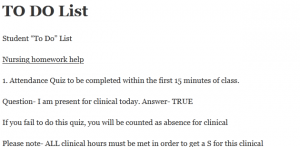TO DO List

Student “To Do” List
1. Attendance Quiz to be completed within the first 15 minutes of class.
Question- I am present for clinical today. Answer- TRUE
If you fail to do this quiz, you will be counted as absence for clinical
Please note- ALL clinical hours must be met in order to get a S for this clinical
2. Go to: https://www.psychiatry.org/patients-families/postpartum-depression/what-is-postpartum-depression read through the information. In a Word document, answer these questions.
a. What is the statistic regarding postpartum depression (what is the ratio of women who experience postpartum depression)?
b. What is the percentage of men who experience depression the first year after a child’s birth?
c. What are three treatment options for PPD.
d. What are the four classes of antidepressants that can be taken in pregnancy?
e. What is the percentage of women who experience an anxiety disorder in pregnancy? Does that percentage increase or decrease in the postpartum period?
Watch the following video:
i. https://www.youtube.com/watch?v=K_3NlTtybIA
ii. https://www.youtube.com/watch?v=JdqhGNmJ_pw
3. Read Chrissy Teigen’s story here: https://www.glamour.com/story/chrissy-teigen-postpartum-depression
i. Group Project
1. Create a concept map with one of the three stories above include in the center “Chrissy Teigen” then from there, talk about her signs/symptoms, treatments, in the last “bubble” why do you feel it’s important for celebrities to talk about their struggle with PPD.
4. Discussion within your groups:
Case Study: Postpartum Depression
Sheela’s Story Sheela was a 30 year-old mother of four children who had been married for eight years. She lived with her husband and in-laws in a small village. She had given birth to her fourth child three months previously. Her pregnancy and labor had been uneventful, and an untrained traditional midwife helped conduct the home delivery. Because pregnancy was viewed in her village as a normal occurrence that did not require any medical attention, Sheela did not receive any antenatal or postnatal care. For a month after the birth, Sheela felt normal, but then she began to exhibit unusual behavior. She became reclusive and stopped speaking to anyone at home, losing interest in her daily activities and ceasing to care for her children. The rest of the people in her family, however, were busy with their own lives and seemed indifferent to her condition. One day, when all of her family members had gone to the fields to work, Sheela set herself on fire and walked out of the house covered in flames. Some neighboring men saw her and smothered the flames with blankets, and one of them ran to get her family from the fields. They called an auto rickshaw to take her to the hospital, where Sheela was admitted to the burns unit. She had sustained 63% superficial and deep burns. Eight days after admission, she died of shock and septicemias.
What were the social, economic, and medical factors that contributed to Sheela’s death? What could have been done to prevent it? Write your answers in a Word Document and submit (one person in your group may write this but you all need to submit the document to the dropbox).
5. Class Discussion of scenario once everyone is done with #4.
6. Watch the documentary “When the Bough Breaks” here: https://www.amazon.com/When-Bough-Breaks-Brooke-Shields/dp/B06XDQZ5SC (choose the free option with ads)
Write a short paragraph on how this made you feel watching these stories. Did they make you anxious, sad, empathetic? Why? How will you be able to convey your emotions in an appropriate manor to your patients in the future? Remember, you are their advocate and one they may lean on in these circumstance.
Postpartum Psychosis
7. Read the short page on postpartum psychosis. What are 5 signs or symptoms? What are 5 interesting facts you found in this short article? Put in a word document and submit
a. https://www.postpartum.net/learn-more/postpartum-psychosis/
b. Watch the following video:
i. https://youtu.be/Xa3HFPMI-_0
ii. https://youtu.be/8qgV7Yug-xs
iii. Group discussion about the videos
8. Research Andrea Pia Yates. Watch the following video: https://www.dailymotion.com/video/x5g8z0j write 10 interesting facts from the video.
9. Research the Edinburgh Postnatal Depression Scale (EPDS). In the discussion post, pick one of the scenarios or articles from today and take the assessment as if you were the individual from the scenario (if some of the questions don’t apply, use your best judgement). What score did you give for your choice and why? How often should women be assessed with the EPDS? At least 200 words
10. Group Work:
a. Use your ATI Templates to complete the following (everyone in the group must submit the documents):
i. Postpartum Depression
ii. Postpartum Psychosis
iii. Medications: SSRIs – Zoloft
11. Return to the discussion board and reply to two of your classmates.
12. Reflection paper: What did you enjoy about today? What was your favorite story and why? How are you going to change your practice towards women who are pregnant or individuals with mental health illness that are in child-bearing age?